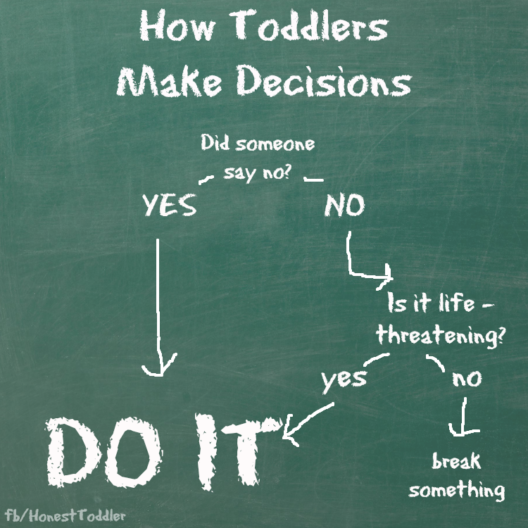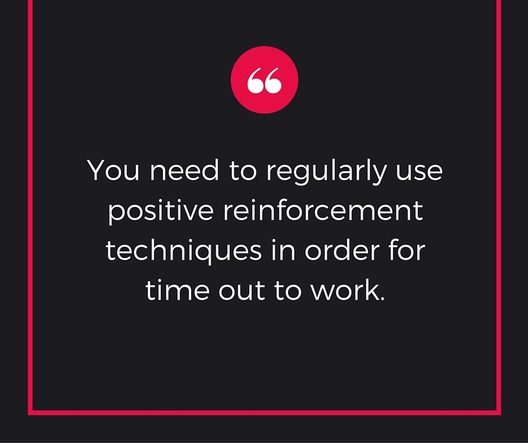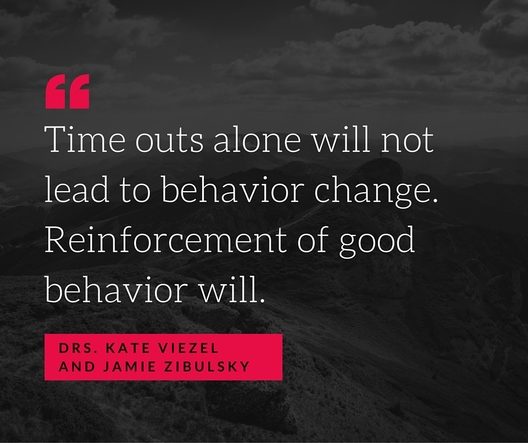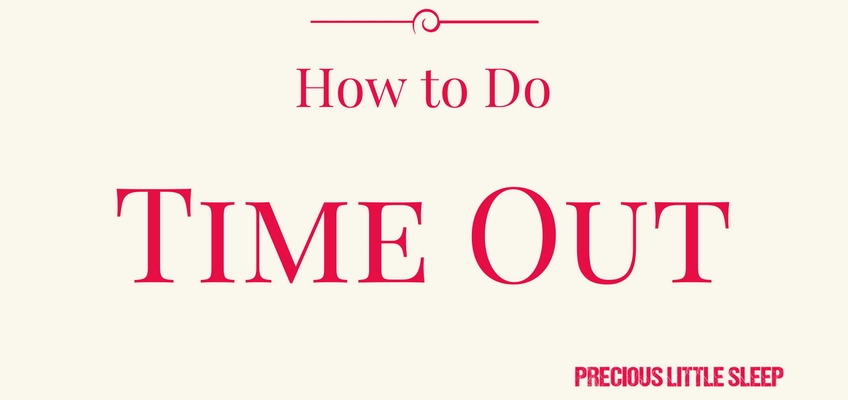Parenting a toddler can make you yearn for the glorious newborn days where you could just carry your compliant child around with you like an adorable loaf of bread. So it’s no surprise that parents find themselves looking for techniques to help manage their toddler’s behavior because toddlers, by their very nature, are often unmanageable. One popular approach is toddler time out: putting your toddler in a chair or some other safe comfortable space for 1-2 minutes. During the toddler time out, your toddler will calm down and quietly reflect on their behavior, identifying their contribution to the current situation and changes they can affect to do better in the future.

I think parents of toddlers gravitate towards the idea of time outs because:
- You can’t reason with a toddler. “If you play in the snow with bare feet they’ll freeze off and you can’t play with your friends with leg stumps!”
- Challenging behavior can feel relentless. “Stop hitting your brother so we can have snack! Why did you stuff your socks in your sippy cup?”
- We worry that we’re losing control. “Yes she’s still naked. I tried to put pants on her for 3 hours and gave up. Shut up and stop judging me!”
- There are clear rules. “Sit in the chair for 3 minutes or Mommy will cry. You don’t want Mommy to cry do you?!!?”
I don’t remember where I first came across the idea of time outs but I believe it was on Super Nanny.
I would watch the videos of parents wrestling their kid into the naughty chair for what appears to be 27 hours while the Benny Hill theme song plays in the background. It’s hard to watch this and feel like it’s a winning strategy. My own attempts played out in much the same way leaving me feel resentful and defeated.
So I asked two child psychologists about it.
Drs. Kate Viezel and Jamie Zibulsky see patients at Fairleigh Dickinson University’s Center for Psychological Services and are trained in Alan Kazdin’s Parent Management Technique (PMT). They also run a year-long PMT externship for psychology students. And they are both parents of young children so they totally “get it.” And this is what they have to say about it…
The Power of Positive Reinforcement
The best way to change behavior isn’t discipline.
Say what now? How do I get my child to stop being a small dictator if I don’t punish her? Well, as psychologists have known since teaching rats how to run through mazes, the best way to change behavior is through positive reinforcement. Rats won’t do much if you shock them when they make a wrong turn, but if you put a piece of cheese at the end of the maze, suddenly you have a little furry Einstein. If you’re offended that we are comparing your child to a rat, clearly you haven’t been subjected to the tiny claws of a tantruming toddler.
What does “positive reinforcement” mean in real life? You need to figure out what you want your child TO do, instead of what NOT TO DO (more on this later). And you need to regularly acknowledge when they do something right. Here are some examples of how to positively reinforce your child:
- Specific verbal acknowledgement, like saying “Great job putting your socks in the drawer!” (which is a more effective way to praise than saying something global like “Good boy!”)
- Positive Attention, such as looking at them and smiling, or playing yet another round of Candy Land
- Touches like hugs or high fives
- Tangible rewards like stickers or treats
Most of us pay way more attention to our children when they do something wrong than when they do something right. Or we may praise exceptional accomplishment while breezing by the run-of-the-mill appropriate things they do every day. But research and experience show that kids behave better when people focus on the things they are doing right, even when those things are as simple as sitting down at the table to eat breakfast.
Tactics for Stubbornness vs. Aggression
Now that you have some strategies you can use when your kiddo is acting the way you want them to, let’s get to the issue you really want to address – what to do when your child is being stubborn or aggressive. By being stubborn (or, more charitably, “developing a sense of autonomy”) we mean those times when your peanut says, “no I won’t wear mittens, no you can’t change my diaper, no I’m not getting in that car seat, no I won’t stop throwing toys down the stairs.” And aggression is anything that hurts bodies or feelings, like hitting, kicking, screaming “I hate you!”, etc.

{H/T Honest Toddler}
If you’re having a hard time getting your kid to follow instructions, first remember the power of positive reinforcement. That means you’ll need to be on the lookout for times when your child DOES put on their shoes the first time you ask. Simply saying “Great job getting in the bath the first time I asked!” (or doing a little happy dance) can work wonders.
Natural Consequences
Assuming you are praising, hugging, high-fiving, and Candy-Landing your kid a ton, another great response to noncompliance is to allow the natural consequence to play out. A natural consequence is anything (positive or negative) that flows organically from the child’s choice.
As an example, if your toddler breaks all their crayons into tiny bits of wax confetti, the natural consequence is that they’ve rendered their crayons unusable for drawing. The next time they want to draw they’ll be disappointed to find their crayons are no longer usable. You don’t lecture or use this moment to toss out a well-deserved “I told you so!” but trust your child to come to their own conclusions and let that inform future decisions. Natural consequences can be challenging for parents because we’ve been conditioned to believe that parenting means actively doing something and it can be hard to just sit back and let life happen without our involvement. It’s hard to get out of the way and trust your child to figure things out. But allowing natural consequences to happen is an enormously powerful and effective parenting strategy.
But what about aggression? Aggression isn’t something you can ignore, and timeout can be an effective strategy to use when bodies or feelings are getting hurt.
If done correctly.
How To Use Toddler Time Out
The time-out is a mild punishment technique that is usually an improvement over what many parents wind up doing when their kids are aggressive (arguing, harsh punishment, yelling, etc).
Time out can be effective, but you should do it consistently and rarely. And you must be regularly using positive reinforcement strategies in order for time out to work.

It is also important to remember that time out only works if you are removing a child from a highly reinforcing environment. Pick a place in your house where your child can sit in time out without any reinforcement or stimulation.
-
Keep it short.
It should be brief; anything longer than 5-8 minutes isn’t any more effective than a shorter time-out, and can lead to additional problems. The minute-per-age rule (three minutes for a three year old) is pretty good, but we would recommend that you max out at about five minutes, regardless of the age of the child. Also, some kids might not be able to do three minutes; in this case, even one minute (or less) is sufficient.
-
Minimize attention.
Time outs should not involve any attention given to the child because any attention can reinforce negative behaviors. Time out should definitely not involve a power struggle. Any attention (even “negative”) defeats the purpose of time out. (Walking the child back to the time out spot a billion times is absolutely a power struggle and nobody wins a power struggle). Physically holding a child in time-out is giving them ALL THE ATTENTION, and carries the risk of accidental injury. If the child refuses to do time out, offer a choice of time-out or a privilege loss. If the child refuses the time out, they lose the privilege. Once the child either does time-out or loses the privilege, let the whole thing go. No one likes a lecture so save the moral discussion for a time when everyone is calm. Take a deep breath, grab the play-dough, and head outside for some fun.
-
The right age.
Keep in the mind that, for all of the reasons above, it may be very tricky (and counterproductive) to give a time out to a child younger than the age of two or three. If you don’t think your child will be able to sit still for a brief time out or understand the concept of privilege loss, then they’re too young. You can still remove your child from the environment that is triggering the aggressive behavior, and pay lots of attention to appropriate behaviors.
-
Positive reinforcement is key.
The most important point is that time outs alone will not lead to behavior change. Reinforcement of good behavior will. If the child is not receiving praise, attention, and rewards for good behavior, all the time outs in the world won’t do a thing. You need to regularly acknowledge when our toddler uses gentle hands with the dog, plays nicely with their brother, and sits still for a diaper change.

Thank you Kate and Jamie for taking the time to share these insights with the crew here! The key takeaway for me is that regardless of how old/young your kids are, or if you do/don’t want to use time out as a strategy, working towards a mindset that is routinely acknowledging the positive in our children is essential. Whether it’s with our words, a smile, a quick hug, or simply spending some time sharing an activity they enjoy, everything begins not so much with changing their behavior, but changing our own. So thank you for the reminder and personally, I’m going to make a huge effort to put your advice to good use.
Got any time out stories or questions you care to share? Fire away with comments below!
